DNA Structure and Function | Biochemistry for MCAT PDF Download
| Table of contents |

|
| DNA (Deoxyribonucleic Acid) |

|
| The molecular structure of DNA |

|
| The Biological function of DNA |

|
| Understanding DNA structure and function |

|
DNA (Deoxyribonucleic Acid)
- DNA is an essential molecule that serves as the carrier of genetic information in living organisms. It acts as a repository of instructions for the synthesis of various proteins. Within each cell of an organism, this vital information is housed in 46 chromosomes, which are composed of numerous smaller segments of DNA known as genes. Each gene contains specific directions for the production of protein fragments, complete proteins, or even multiple distinct proteins.
- The unique molecular structure of DNA, coupled with the remarkable efficiency of specialized enzymes, enables it to fulfill its crucial biological role. These enzymes have evolved to interact precisely with the molecular structure of DNA, facilitating various processes related to gene expression. The exceptional compatibility between DNA's structure and the activities of these enzymes has established DNA as the universal molecule for storing, expressing, and transmitting instructions for protein synthesis across all forms of life. Throughout the course of evolution, no alternative molecule has emerged that surpasses the effectiveness of DNA in carrying out these fundamental functions.
The molecular structure of DNA
DNA, or deoxyribonucleic acid, possesses a unique molecular structure that is pivotal to its biological function. To comprehend this structure, it is essential to familiarize oneself with the terminology associated with the constituent components of DNA and how these components combine to form DNA molecules.
DNA molecules are polymers
DNA molecules are classified as polymers, which are extensive structures constructed by repeatedly linking together smaller units known as monomers. A useful analogy is envisioning a freight train, where individual boxcars are connected in a sequence, or constructing a sentence by combining specific letters in a particular order. Similarly, in the case of DNA, monomers called nucleotides are assembled in a chain-like fashion to form the DNA polymer.
DNA monomers are called nucleotides
Nucleotides serve as the monomers of DNA. Just as individual letters form the building blocks of a sentence polymer, DNA polymers are formed by linking together nucleotide monomers. The DNA alphabet consists of four nucleotide monomers: A (adenine), C (cytosine), T (thymine), and G (guanine). Each nucleotide monomer comprises three molecular components: a sugar, a phosphate group, and a nucleobase. It is important to note that the term "base" here refers to a distinct concept and should not be confused with a substance that alters the pH of a solution.
The sugar and acid in all four monomers are the same
All four nucleotide monomers share a common sugar and acid composition. The sugar present in each nucleotide is called deoxyribose. Deoxyribose is a cyclic molecule with a ring-like structure composed of one oxygen atom and four carbon atoms. An additional carbon atom is attached to the fourth carbon of the ring structure. Deoxyribose also features a hydroxyl group (-OH) connected to the third carbon within the ring structure.
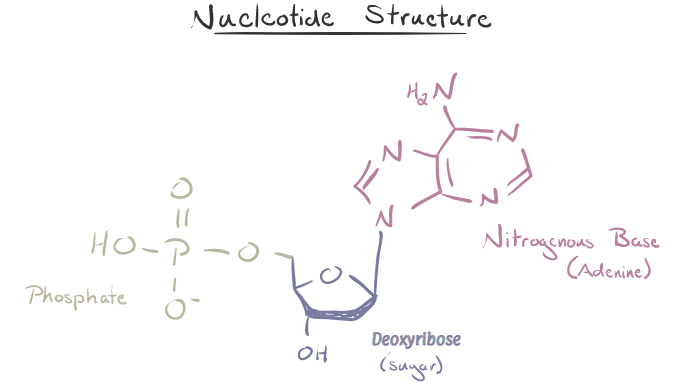
The phosphate group, a crucial component of nucleotides in DNA, consists of a phosphorus atom bonded to four oxygen atoms. The phosphorus atom within the phosphate group exhibits a notable affinity for bonding with other oxygen atoms, such as the oxygen atom extending from the deoxyribose sugar of another nucleotide. This propensity for bonding allows for the formation of the backbone of the DNA molecule, as the phosphate groups link together, creating a continuous chain.
The four nucleotide monomers are distinguished by their bases
Each type of nucleotide has a different nucleobase stuck to its deoxyribose sugar.
- A nucleotide contains adenine
- T nucleotide contains thymine
- G nucleotide contains guanine
- C nucleotide contains cytosine
All four of these nucleobases are relatively complex molecules, with the unifying feature that they all tend to have multiple nitrogen atoms in their structures. For this reason, nucleobases are often also called nitrogenous bases.
Phosphodiester bonds in DNA polymers connect the 5’ carbon of one nucleotide to the 3’ carbon of another nucleotide
- The nucleotide monomers within a DNA polymer are joined together by strong electromagnetic attractions known as phosphodiester bonds. These bonds are a type of covalent bond, which is a broader category of electromagnetic attractions between atoms recognized by chemists.
- To facilitate discussions about the molecular structure of nucleotides, biochemists have devised a numbering system. This system assigns numbers to the carbon atoms in the sugar component of the nucleotide. The numbering starts with the carbon atom immediately to the right of the oxygen atom in the deoxyribose ring and continues in a clockwise manner. The numbers range from 1' (referred to as "one prime") for the carbon adjacent to the oxygen atom, to 5' ("five prime") for the carbon extending from the fourth carbon in the deoxyribose ring.
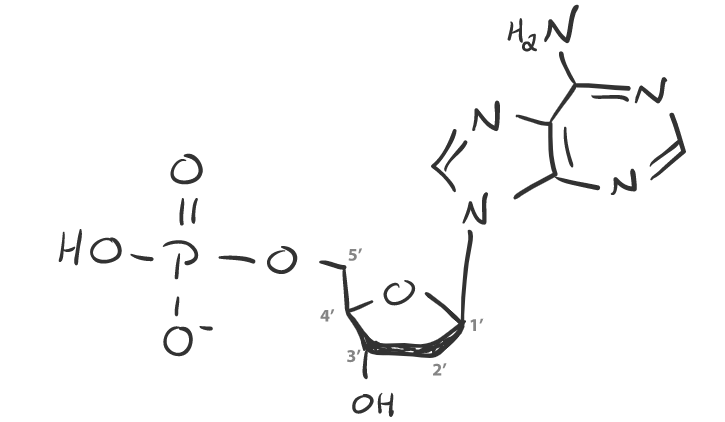
- The phosphodiester bonds that connect DNA nucleotides always establish a linkage between the 3' carbon of the first nucleotide and the 5' carbon of the second nucleotide. This results in a covalent bond forming between the oxygen atom attached to the 3' carbon of the first nucleotide and the phosphorus atom in the phosphate group attached to the 5' carbon of the second nucleotide. These particular bonds are known as 3'-5' phosphodiester bonds.
- During the formation of these bonds, a water molecule is eliminated through a process called dehydration synthesis. This process is responsible for removing water as nucleotides are joined together, facilitating the synthesis of polymers. Dehydration synthesis is utilized by various molecules to aid in the formation of larger, complex structures.
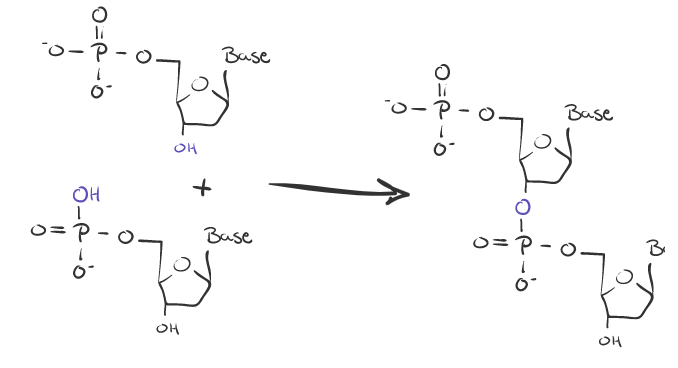
Chromosomes are made of two DNA polymers that stick together via non-covalent hydrogen bonds
- Chromosomal DNA is composed of two DNA polymers that form a three-dimensional structure known as a double helix. Within this double helix, the individual strands of DNA run in opposite directions, which is referred to as being antiparallel. Specifically, the 5' end of one DNA strand aligns parallel to the 3' end of the other DNA strand. This antiparallel arrangement is a fundamental characteristic of the DNA double helix structure.
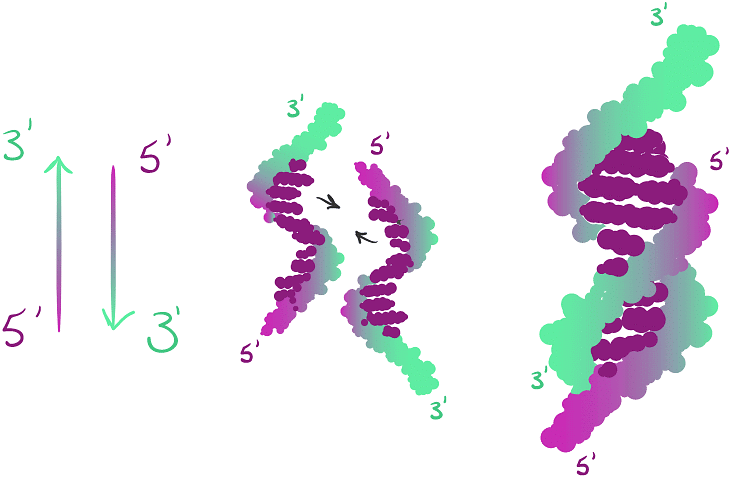
- The nucleotides within each DNA strand are connected by hydrogen bonds, which are noncovalent bonds. Individually, hydrogen bonds are weaker than covalent bonds such as phosphodiester bonds. However, the large number of hydrogen bonds formed between the two DNA polymers results in a strong overall connection between them.
- The hydrogen bonds in DNA occur between specific hydrogen atoms on one nucleotide base (donors) and specific oxygen or nitrogen atoms on the base across from it (acceptors). Adenine (A) and Thymine (T) form one hydrogen bond between them, while Cytosine (C) forms two hydrogen bonds with Guanine (G), and G forms two hydrogen bonds with C. This specific pairing of nucleotides is known as complementary base pairing.
- The consistent and specific complementary base pairing between A and T, and between C and G, plays a crucial role in maintaining the nucleotide sequences of the two DNA polymers that make up a chromosome. This was discovered by Erwin Chargaff, who observed that the percentage of A nucleotides always equals the percentage of T nucleotides, and the percentage of G nucleotides always equals the percentage of C nucleotides (with a small margin of error). This consistency in base pairing can be explained by the hydrogen bonding between donors and acceptors on the nucleotide bases.
- Overall, complementary base pairing and hydrogen bonding contribute to the stability and fidelity of DNA structure, ensuring the accurate transmission of genetic information during processes such as DNA replication and protein synthesis.
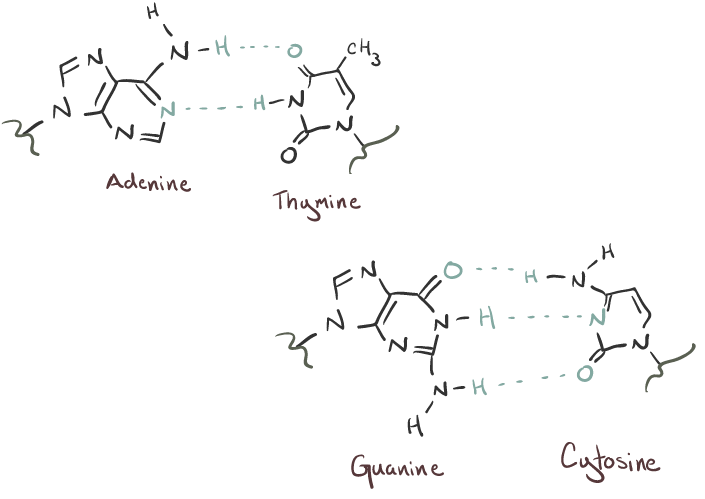
The Biological function of DNA
DNA polymers direct the production of other polymers called proteins
- Proteins are essential molecules within cells and play a crucial role in various biological processes. They are composed of one or more polymers made up of monomers called amino acids. Amino acids are linked together through covalent bonds to form chains, which then fold into specific three-dimensional structures.
- Proteins serve as the workhorses of cells, carrying out a wide range of functions. One of their primary roles is acting as enzymes, which catalyze biochemical reactions and facilitate metabolic processes in the body. Enzymes accelerate chemical reactions, enabling cells to efficiently perform vital tasks.
A chromosome consists of smaller segments called genes
- Chromosomes are large structures found in the nucleus of cells, and they play a crucial role in the organization and transmission of genetic information. Each chromosome is made up of two DNA polymers, also known as DNA strands or DNA molecules, which are arranged in a double helix structure.
- The two DNA polymers in a chromosome are connected by hydrogen bonds that form between complementary base pairs. Adenine (A) always pairs with thymine (T), and cytosine (C) always pairs with guanine (G). These base pairs are held together by hydrogen bonding, creating the stability necessary for the structure of DNA. The DNA within a chromosome is divided into segments called genes.

Each gene is further divided into three nucleotide subsegments called codons
A codon is a sequence of three nucleotides found within double-stranded DNA. It can be considered as a building block of genetic information. A gene, on the other hand, can be visualized as a collection of multiple three-nucleotide codons connected together in a specific sequence.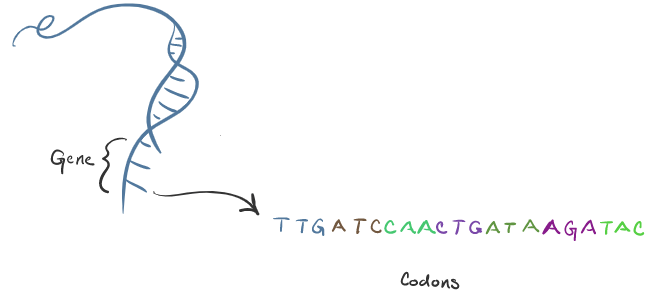
 |
Download the notes
DNA Structure and Function
|
Download as PDF |
Understanding DNA structure and function
- Drawing an analogy between DNA and language, we can further explore how DNA stores biological information. If nucleotides are likened to letters, then codons can be considered as words. While the English language employs 26 letters to form words of varying lengths and meanings, our cells utilize the four DNA nucleotides to construct "words" known as codons, which are consistently three nucleotides long. By examining the possibilities, we find that there are precisely 64 potential combinations of these nucleotides, forming the vocabulary of the DNA language.
- Similar to how each word in English is associated with a specific definition in a dictionary, each codon in the DNA language corresponds to a particular amino acid. During the process of translation on ribosomes, every codon from the original DNA gene is matched with its corresponding amino acid, facilitated by tRNA molecules. Just as a reader assembles the definitions of words to comprehend the meaning of a sentence, a ribosome brings together the amino acids indicated by each codon in a gene, establishing covalent bonds between them to synthesize a protein.
A simplified example
- Let's consider a simplified organism that produces only four proteins, each composed of four amino acid monomers. The characteristics and traits of this organism, including its appearance, movement, and feeding behavior, are entirely determined by the functions of these four proteins.
- The genes responsible for producing each of the four proteins are distributed across two chromosomes. Therefore, each chromosome carries two genes. Since the proteins encoded by these genes consist of four amino acid monomers, each gene must consist of four codons. Since a codon is composed of three nucleotides, each gene comprises a total of 12 nucleotide monomers. Consequently, each chromosome has a length of 24 nucleotides, accommodating the genetic information necessary for synthesizing the corresponding proteins.
Consider the following: junk DNA and junk DNA reporting
- In our simplified example, the genome of the imaginary organism does not precisely reflect the structure of actual genomes. While chromosomes primarily consist of nucleotides (along with some proteins), they are not solely composed of genes, and genes are not exclusively made up of codons.
- In reality, less than ten percent of the nucleotides in chromosomes are part of genes. The remaining nucleotides are considered "junk DNA" and act as filler between genes, similar to random letters inserted between sentences in a paragraph. This non-gene portion of DNA contains regulatory elements and other sequences with functions that are still being studied.
- Junk DNA is not only found between genes but can also exist within them. Codons are often separated by nucleotide regions called introns, which do not code for amino acids and can be compared to blank spaces used to separate paragraphs on a page. Cells possess spliceosomes, a type of enzyme, which can recognize and remove introns from genes during the process of transferring genetic information to ribosomes. You can find more information about this process in our articles on DNA transcription and translation.
- The discussion of junk DNA and introns was not initially included when exploring the structure and function of DNA because they are not crucial to the fundamental concepts. They represent intriguing complexities that exist alongside the more essential aspects. Unfortunately, there is another complexity within the DNA story that often goes unmentioned in scientific and media discussions, but it is crucial to understanding how DNA functions.
- If you have come across statements claiming that a gene "for" a particular human trait has been discovered, you are already familiar with the complexity I am referring to. While your DNA contains junk nucleotides, many news outlets, television broadcasts, and websites are filled with misleading information about DNA and its role in determining human traits.
- What genes are truly "for" is the production of proteins, as we have discussed. They provide instructions to ribosomes for assembling amino acid monomers into protein polymers. Traits, ranging from simple characteristics like eye color to complex attributes such as autism or exceptional athletic ability, arise from intricate interactions among proteins, the cells that produce them, and the surrounding environment. These interactions are influenced by various factors including non-biological elements such as diet (relatively comprehensible) and social-economic status or parenting (extremely challenging to quantify and map onto biological processes). Referring to any single gene as being solely "for" a specific human trait is usually a significant oversimplification.
- The next time you encounter news reports claiming an exciting discovery of a gene "for" a particular trait, try interpreting it as follows: "A statistical scientific study has produced some evidence suggesting a potential correlation between the presence or absence of a gene and the manifestation of a specific trait in a limited sample of a larger human population—but further research is required." This way of framing the story will likely bring you closer to the truth, which is always a more accurate perspective to have.
|
138 videos|21 docs|4 tests
|

























